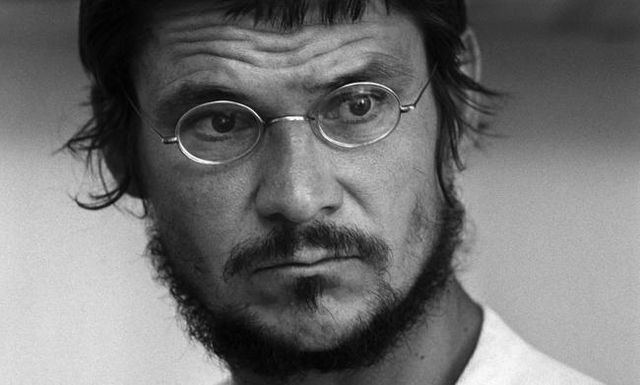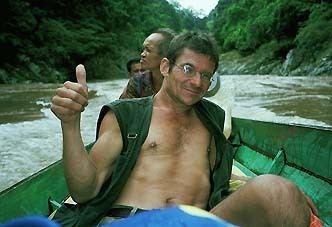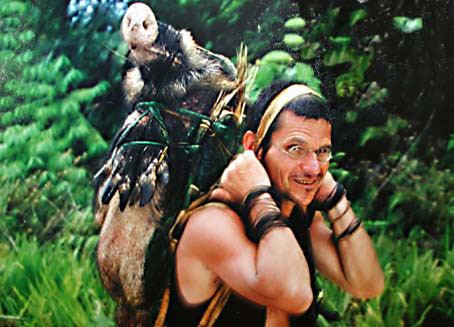Name Bruno Manser | ||
 | ||
Status Legally dead on 10 March 2005 Other names Laki PenanLaki TawangLaki e'h metat Occupation Human rights activistEnvironmentalist Died March 10, 2005, Sarawak, Malaysia | ||
Why was Bruno Manser important for the environmental movement?
OFFICIAL TRAILER: The Borneo Case - Bruno Manser lebt weiter
Bruno Manser (born 25 August 1954, declared dead 10 March 2005) was a Swiss environmental activist. From 1984 to 1990, he stayed with the Penan tribe in Sarawak, Malaysia, organising several blockades against timber companies. After he emerged from the forests in 1990, he engaged in public activism for rainforest preservation and the human rights of indigenous peoples, especially the Penan, which brought him into conflict with the Malaysian government. He also founded the Swiss non-governmental organization (NGO) Bruno Manser Fonds in 1991. He disappeared during his last journey to Sarawak in May 2000 and is presumed dead.
Contents
- Why was Bruno Manser important for the environmental movement
- OFFICIAL TRAILER The Borneo Case Bruno Manser lebt weiter
- Early life and education
- Searching for Penans
- Life with the Penans
- Activism
- Response from Malaysian authorities
- Response by Malaysian federal government
- Response by Sarawak state government
- Dealing with Abdul Taib Mahmud
- Bruno Manser Fonds
- Disappearance
- Search expeditions
- Aftermath
- Books
- Films
- References

Early life and education

Bruno Manser was born in Basel on 25 August 1954 in a family of three girls and two boys.

During his younger days, Manser was an independent thinker. His parents wanted him to become a doctor, and he studied medicine informally. He completed his baccalaureate, the first in his family to do so.

Manser spent three months in Lucerne prison when he was 19 years old because, as an ardent follower of non-violent ideologies espoused by Mahatma Gandhi (Satyagraha) he refused to participate in Switzerland's compulsory military service. After leaving prison in 1973, he worked as a sheep and cow herder at various Swiss Alpine pastures for 12 years. During this time, he became interested in handicrafts, therapeutics, and speleology. He laid bricks, carved leather, kept bees, and wove, dyed, and cut his own clothes and shoes. He also regularly pursued mountaineering and technical climbing.
At the age of 30, he went to Borneo, looking to live a simpler life.
Searching for Penans
In 1983, Manser went to the Malaysian state of Terengganu and stayed with a family. In 1984, while learning more about the rainforests, Manser learned of a nomadic tribe called known as the Penan tribe. After learning more about the tribe, he decided to attempt to live with the Penan tribe for a few years and traveled to the East Malaysian state of Sarawak in 1984 on a tourist visa.
In Malaysia, he first joined an English caving expedition to explore Gunung Mulu National Park. After the expedition, he stepped deeper into the interior jungles of Sarawak, intending to find the "deep essence of humanity" and "the people who are still living close to their nature." However, he quickly became lost and ran out of food while exploring the jungle, then fell ill after eating a poisonous palm heart.
After these setbacks, Manser finally found Penan nomadic tribes near the headwaters of the Limbang river at Long Seridan in May 1984. Initially, the Penan people tried to ignore him. After a while, the Penans accepted him as one of their family members.
In August 1984, Manser went to Kota Kinabalu, Sabah to obtain a visa to visit Indonesia. On the Indonesian visa, he entered Kalimantan, then illegally crossed the border back into Long Seridan, Sarawak.
His Malaysian visa expired on 31 December 1984.
Life with the Penans
Manser learned about survival skills in the jungle and familiarized himself with the Penan's culture and language. The Penan tribal leader in Upper Limbang, named Along Sega, became Manser's mentor. During his stay with the Penan tribe, Manser adopted their way of life. He dressed in a loincloth, hunted with a blowgun, and ate primates, snakes, and sago. Manser's decision to live as a member of the Penan tribe was ridiculed in the West, and he was dismissed as a "White Tarzan". Within the Penan tribe, however, Manser was known as "Laki Penan" (Penan Man), having earned the respect of the Penan tribe that adopted him.
Manser created notebooks that were richly illustrated with drawings, notes, and 10,000 photographs during his six-year stay from 1984 to 1990 with the Penan people. Some of his sketches include cicada wing patterns, how to carry a gibbon with a stick, and how drill holes on a blowpipe. These notebooks were later published by Christoph Merian Verlag press in Basel. Manser also created audio recordings of oral histories told by Penan elders and translated them. He claimed that the Penan people were never argumentative or violent during his time with the Penan tribe.
In 1988, Bruno Manser tried to reach the summit of Bukit Batu Lawi but was unsuccessful, finding himself hanging on a rope without anything to grab on for 24 hours. In 1989, Manser was bitten by a red tailed pit viper but he was able to treat the snake bite himself. He also got a malaria infection while living in the jungles.
Unfortunately, deforestation of Sarawak's primeval forests started during Manser's stay with the Penan tribe. As a result, the Penans suffered from reduced vegetation, contaminated drinking water, fewer animals available for hunting, and the desecration of their heritage sites. Manser worked with Along Sega to teach the Penan tribe how to organize road blockades against advancing loggers. Manser organised his first blockade in September 1985.
Activism
Manser gave many lectures in Switzerland and abroad, making connections to people within the European Union (EU) and the United Nations (UN). As an activist, he visited American and African jungles, staying in various locations for a few weeks.
He returned almost every year after leaving the Penan tribe to follow up with the logging activities and to provide assistance to the tribe, often entering these areas illegally, crossing the border with Brunei and Kalimantan, Indonesia. He discovered that logging conglomerates such as Samling, Rimbunan Hijau, and the WTK group of companies continued their operations in Sarawak rainforests. As a result, Manser organised the Voices for the Borneo Rainforests World Tour after he left the Sarawak forests in 1990. Manser, Kelabit activist Anderson Mutang Urud, and two Penan tribe members travelled from Australia to North America, Europe, and Japan.
On 17 July 1991, Manser climbed unaided to the top of 30-foot high lamp post outside of the G7 media centre in London. After reaching the top, he unrolled a banner that displayed a message about the plight of Sarawak rainforests. He chained himself to the lamp post for two and a half hours. His protest also coincided with protests by Earth First! and the London Rainforest Action Group. Police used a hoist to reach the top of the lamp post and cut his chains. Manser climbed down the lamp post without force at 1:40 PM. He was then taken to the Bow street police station and held until the G7 summit ended at 6:30 PM, when he was released without being charged with an offense.
In June 1992 he parachuted into a crowded stadium during the Earth Summit in Rio de Janeiro, Brazil.
In December 1992, Manser led a 20-day hunger strike in front of the Marubeni Corporation headquarters in Tokyo, Japan.
In 1993, Manser went on a 60-day hunger strike at the Federal Palace of Switzerland ('"Bundeshaus") to press the Swiss parliament on enforcing a ban on tropical timber imports and mandatory declarations of timber products. The hunger strike was supported by 37 organisations and political parties. Manser only stopped the hunger strike after his mother requested that he do so. After Manser's disappearance, the Swiss parliament finally adopted the Declaration of Timber Products on 1 October 2010, with a transition period allowed until the end 2011.
In 1995, Manser went to Congo rainforests to document the effects of wars and logging on Ituri pygmies.
In 1996, in the German-language programme "fünf vor zwölf" (At the eleventh hour), Manser and Jacques Christinet used auxiliary cable to drop themselves down 800 meters onto the Klein Matterhorn aerial cable car and hung sizable banners there. They reached the dangerous speed of 140 kilometers per hour while riding on a self-made rider with steel wheels and ball bearings.
In 1997, Manser and his friend Jacques Christinet tried to enter Peninsular Malaysia from Singapore to fly a motorised hang-glider during the 1998 Commonwealth Games in Kuala Lumpur. However, he was recognised at the border and denied entry into Malaysia. They then decided to swim across the Straits of Johor into Malaysia but later abandoned the plan, because it involved a lengthy 25-kilometer swim and a passage through a swamp across the straits. They planned an alternate route, opting to row a boat from an island in Indonesia into Sarawak, but Bruno Manser Foundation (BMF) in Switzerland received a warning from Malaysian embassy, warning of the consequences for such an act.
In 1998, Manser and his friend Jacques Christinet travelled to Brunei and swam across the 300-metre wide Limbang river at night. Manser's friend was almost fatally injured by drifting logs along the river. They spent 3 weeks in Sarawak hiding from the police. During that time period, they attempted to order four tons of 25-centimeter nails for the Penan tribe to hammer into the tree trunks. These nails could have caused serious injuries to the loggers when the embedded nails inevitably came into contact with chainsaws.
After hearing of Manser's actions, Al Gore condemned logging activities in Sarawak. Prince Charles also described the treatment for the Penan tribe as "genocide." The British Broadcasting Corporation (BBC) and the National Geographic Channel produced documentaries about the Penan tribe, and Penan stories were also featured on Primetime Live. Universal Studios started to develop an action-adventure horror script where the Penan tribe used their forest wisdom to save the world from catastrophe. Warner Bros also developed a script on Bruno Manser story. The Penan tribe also received coverage in Newsweek, Time, and The New Yorker.
Response from Malaysian authorities
Manser's actions drew anger from Malaysian authorities, and he was nearly arrested in 1986. Manser also became persona non grata (an unwelcome person) in Malaysia. A reported bounty for his capture ranged from US$30,000 to US$50,000 has been circulated by word-of-mouth, but the source of the bounty is unknown. By 1990, Malaysia declared Bruno Manser as the "number one enemy of the state" and sent special units to search for him. Using a forged passport and styling his hair differently, Manser returned to Switzerland in 1990 to inform the public about the situation in Sarawak through the Swiss media.
Bruno Manser was nearly imprisoned twice in Sarawak, but managed to avoid being jailed. He was first arrested on 10 April 1986 after being spotted by police inspector Lores Matios. While on holiday at Long Napir, Limbang, Matios arrested Manser and brought him to Limbang police station. Manser was not handcuffed, as the inspector did not carry them while on holiday. During the 90-minute ride to Limbang, the Land Rover that carried Manser came close to running out of petrol. Manser jumped out of the Land Rover and dived into a local river as the vehicle was being refilled with petrol. Matios shouted at him and used his pistol to fire two shots at Manser. Manser lost all of the notebooks he had been working on for the previous four years. Bruno Manser was nearly arrested for a second time on 25 March 1990 after meeting the same police inspector on a flight from Miri, Malaysia to Kuching. The police inspector was on his way to take a law exam in Kuching. However, the inspector did not arrest Manser.
Response by Malaysian federal government
The prime minister of Malaysia, Mahathir Mohamad blamed Manser for disrupting law and order. Mahathir also wrote a letter to Manser, telling him that it was "about time that you stop your arrogance and your intolerable European superiority. You are no better than the Penan."
In March 1992, Mahathir wrote another letter to Manser:
As a Swiss living in the laps of luxury with the world's highest standard of living, it is the height of arrogance for you to advocate that the Penans live on maggots and monkeys in their miserable huts, subjected to all kinds of diseases.
Response by Sarawak state government
The Sarawak government defended its logging policy by stating that revenue from timber sales is needed to feed more than 250,000 of the state population. Sarawak chief minister Abdul Taib Mahmud said, "It is hoped that outsiders will not interfere in our internal affairs, especially people like Bruno Manser. The Sarawak government has nothing to hide. Ours is an open liberal society." Sarawak Minister of Housing and Public Health, James Wong said that "We don't want them [the Penan people] running around [in jungles] like animals. No one has the ethical right to deprive the Penans of the right to assimilation into Malaysian society." The Sarawak government tightened the entry of foreign environmentalists, journalists, and film crews into the state. Sarawak government also allowed logging companies to hire criminal gangs to subdue the indigenous people.
Dealing with Abdul Taib Mahmud
In mid-1998, Manser offered an end of hostilities with Sarawak government if Sarawak chief minister Abdul Taib Mahmud would be willing to cooperate with him to create a biosphere around the Penan tribe's territory. Manser also wanted the government to forgive him for breaking Malaysian immigration laws. The offer was denied. His successive attempts to establish communications with chief minister failed.
Manser planned to deliver a lamb named "Gumperli" to Taib Mahmud by air as a symbol of reconciliation with the chief minister during the Hari Raya Aidilfitri celebration. However, the Malaysian consulate at Geneva, Switzerland pressured airlines not to transport the lamb to Sarawak. Manser later carried the lamb with him on a plane and parachuted over the United Nations Office at Geneva, hoping to bring international attention to Sarawak rainforests problem.
In March 1999, Manser successfully passed Kuching immigration by disguising himself in a business suit, carrying a briefcase, and wearing a badly knotted tie. On 29 March 1999, he flew a motorised paraglider, carrying a toy lamb knitted by himself while wearing a T-shirt with the image of a sheep and made a few turns above Taib's residence in Kuching, Sarawak. There were 10 Penan tribe members waiting on the ground to greet Manser. At 11:30 AM, he landed the glider beside a road just outside Taib's residence and was immediately arrested. He was then transported to Kuala Lumpur on Malaysia Airlines flight MH 2683. He briefly stayed at a prison in Kuala Lumpur. He was seen playing with his knitted toy lamb by his jailers. He was later deported back to Switzerland.
By 2000, Manser admitted that his efforts did not bring positive changes to Sarawak. His success rate in Sarawak was "less than zero" and he was deeply saddened by the result. On 15 February 2000, just before his last trip to Sarawak, Manser said that, "[t]hrough his (Taib) logging license policies, Taib Mahmud is personally responsible for the destruction of nearly all Sarawak rainforests in one generation."
Bruno Manser Fonds
In 1991, Manser set up Bruno Manser Fonds (BMF), a fund designed to help conserve the rainforests and the indigenous population in Sarawak. Manser ran the fund from his home at Heuberg 25, Basel, Switzerland. In 2008, BMF was moved to Socinstrasse 37.
By 2000, BMF raised US$10,000 to set up a mobile dental clinic for the Penan tribe, but the Sarawak government refused to co-operate on the project.
Disappearance
On 15 February 2000, Manser left to visit his Penan nomadic friends via the jungle paths of Kalimantan, Indonesia, accompanied by BMF secretary John Kuenzli and a film crew. After a period of time, the film crew and John Kuenzli left Manser in Kalimantan jungles. At the time, Manser was still writing postcards to his friends.
After the film crew and the secretary left, Manser continued his journey with another friend who knew the way around the territory. The trip continued for two weeks, crossing mountains and rivers on foot and by boat. Manser slept on a hammock while his friend slept on the ground. On 18 May, they reached the Sarawak/Kalimantan border, spending their final night there. Manser asked his friend to carry a postcard back to his girlfriend in Switzerland. According to his friend, Manser looked healthy when they parted ways. Manser complained about diarrhoea and a broken rib in the postcard.
According to BMF secretary John Kuenzli, Manser crossed the Sarawak/Kalimantan border on 22 May with the help of a local guide. His last known communication was a letter mailed to his girlfriend, Charlotte, while hiding in Bario. In the letter, Manser said he was very tired while waiting for the sun to set before continuing his journey along the logging roads. The letter was deposited at the Bario post office and reached Switzerland with a Malaysian stamp but without a post office stamp. Manser was last seen carrying a 30-kilogram backpack by his Penan friend, Paleu and Paleu's son on 25 May 2000. They accompanied Manser until they saw Bukit Batu Lawi (2000-metre limestone pinnacle in Sarawak). Manser stated his intention to climb the mountain alone and requested Paleu to leave him there. Manser has not been seen since.
Search expeditions
BMF and the Penan tribe tried to search for Manser without any success. Areas around the Limbang river were searched by the Penan people. Penan expedition teams tracked Manser to his last sleeping place. They followed Manser's machete cuts into the thick forests until the trail reached the swamp at the foot of Bukit Batu Lawi. There was no trace of him in the swamp, going back from the swamp, or trace of anyone else coming into the area. BMF sent a helicopter to circle the limestone pinnacles. However, none of the search teams were willing to scale the last 100 metres of steep limestone that formed the peak of Batu Lawi. It is possible that Manser fell down the side of the mountain but neither his body nor his belongings have been found. However, two local guides who brought Manser across the jungles of Sarawak were found. In desperation, fortune tellers and Penan necromancers were called. All of them agreed Bruno Manser was still alive. On 18 November 2000, BMF requested that the Federal Department of Foreign Affairs (FDFA) search for Bruno Manser. Investigations were carried out at the Swiss Consulate in Kuala Lumpur and the Swiss Honoarary Consulate in Kuching.
Aftermath
In January 2002, hundreds of Penan tribe members organised a tawai ceremony to celebrate Manser. The Penan people refer to Manser as Laki Tawang (man who has become lost) or Laki e'h metat (man who has disappeared), rather than his name, because speaking the names of the dead is taboo in Penan culture.
On 18 Nov 2001, 18 months after his disappearance, he was awarded the International Society for Human Rights prize for Switzerland.
After search expeditions proved fruitless, a civil court in Basel-Stadt declared Manser to be legally dead on 10 March 2005. On 8 May 2010, a memorial service was held in Elisabethen church, Basel to mark the 10th anniversary of his disappearance. Roughly 500 people attended the church service.
To celebrate Manser's 60th birthday on 25 August 2014, a species of goblin spider that was discovered by a Dutch-Swiss research expedition in Pulong Tau National Park, Sarawak in the 1990s is now named after Manser: Aposphragisma brunomanseri.
Books
Films
Manser made a film documentary:
Several documentary films have been made about him. They are:
